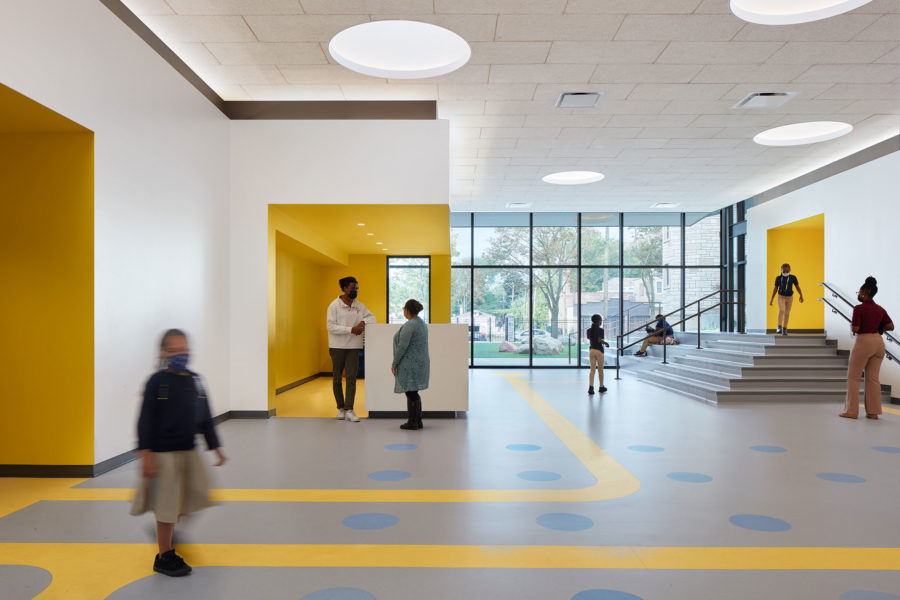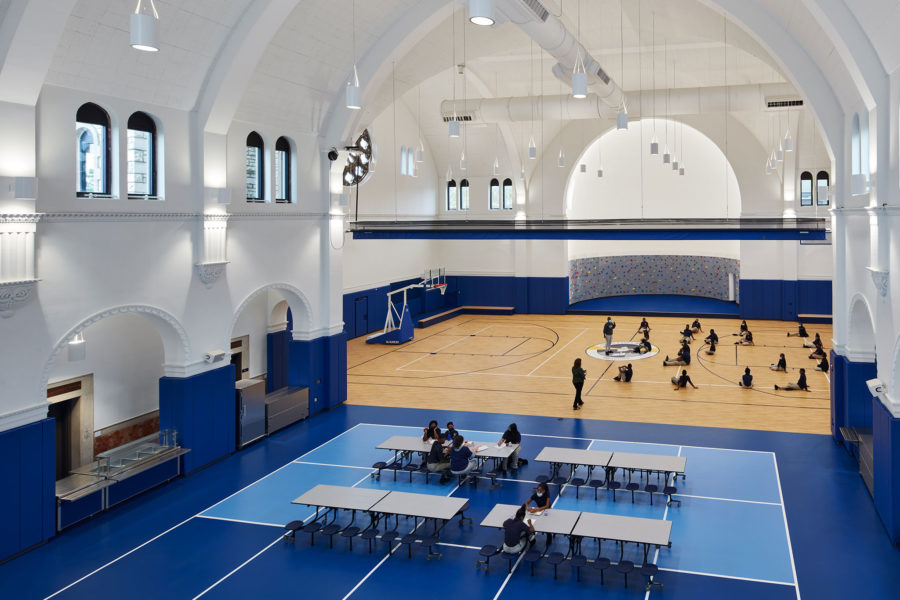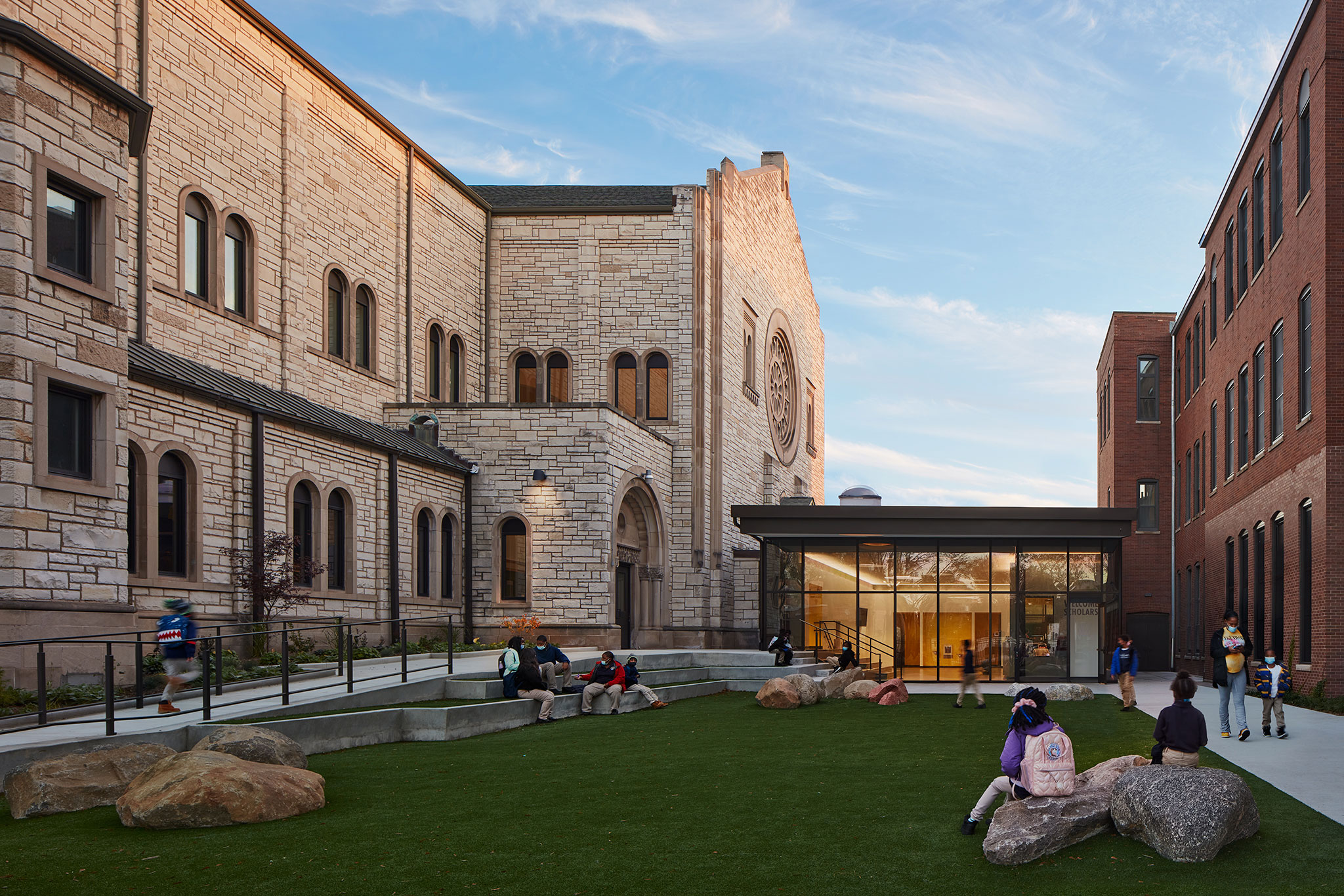Story at a glance:
- Wheeler Kearns Architects reimagined buildings for a charter school and incorporated daylight, a green roof, and variable refrigerant flow units.
- The team repurposed the ground floor of the original building into classrooms while transforming a former church interior into an enrichment center.
- They reduced the embodied carbon of the new campus by reusing the existing buildings and creating a new link between them.
Like many cities in the US, Chicago has neighborhoods that have suffered from decades of disinvestment. Yet many of these areas have stranded assets with vast potential. When paired with the right design team, social entrepreneurs like Great Lakes Academy can unlock that potential, bring enormous benefits to the organization, and enrich the existing neighborhood and community.
In 2012 the team at Wheeler Kearns Architects began working with Great Lakes Academy (GLA), an aspiring charter school seeking its first campus. We looked for existing facilities that could support learning while meeting the financial constraints of the new organization. Fortunately, a facility on the south side of Chicago fit the bill—a former school still owned by the Archdiocese of Chicago.
In 2014 Great Lakes Academy started renting space in a three-story brick building built in 1911 as a multipurpose building. Originally a worship space, the first floor was converted to a combined cafeteria and gymnasium and the two upper floors into classroom spaces. In their inaugural year, GLA started with only kindergarten and first grade, with plans to add a grade level every year until its oldest students reached eighth grade.
In 2018, knowing GLA would soon outgrow its rental space, we began planning to expand its footprint. We considered multiple options to relocate the gym and cafeteria, including building a ground-up facility across the street. Ultimately the school concluded it made the most financial and programmatic sense to acquire the entire campus from the Archdiocese and repurpose the existing adjacent church, built in 1952. While the Covid-19 pandemic presented some property appraisal challenges, it also provided opportunities through favorable lending rates and an increased appetite for New Market Tax Credit investors. GLA made the most of the situation with the help of some great partners, and as a result, by January 2021, GLA owned nearly an entire city block.
Since the existing brick school building and the stone-clad church were in good condition, we made plans to connect them. GLA decided to demolish two other neglected buildings to make room for a new turf field, diverting stormwater and reducing groundwater runoff.
Creative Adaptive Reuse

Cheerful colors and LED lights bring vibrancy to the renovated charter school. Photo by Kendall McCaugherty, Hall + Merrick Photographers
Our design goal was straightforward: to repurpose the ground floor of the original building into classrooms while transforming the church interior into an enrichment center, which would serve as the new cafeteria while supporting fitness and arts programs. We designed the link between the buildings as a new lobby and connection point for both buildings.
Though the decision to reuse existing buildings was born of financial limitations, it became a sustainable strategy. We radically reduced the embodied carbon of the new campus by reusing the existing church and school buildings and nestling a new link between them. Instead of constructing a new 30,000-square-foot building across the street, we built a new 4,000-square-foot link and repurposed a 20,000-square-foot structure with soaring ceilings.
In addition, we employed several sustainable strategies throughout the campus. The link building uses variable refrigerant flow units for electrified heating and cooling and utilizes energy recovery of the exhaust air to precondition the incoming outside air used for ventilation. Large expanses of thermally broken curtainwall framing at the north and south facades, along with nine large roof skylights, substantially limit the need for artificial lighting during daylight hours. The skylights, along with a native planted green roof, are visible from the classrooms and offices on the upper floors and serve as a valuable sustainability teaching tool for students.
Designing the Link
Although compact, we designed the link to solve multiple challenges, including security, toileting, and accessibility. First and foremost, the link simplifies security by providing a single point of arrival for students arriving through the north courtyard and from the vehicle drop-off lanes to the south. In addition, we designed informal areas for students to wait during pickup hours and open spaces for teachers to facilitate dismissal and hold extracurricular activities.
Gender-Neutral Restrooms
In a discrete area of the link, we designed 12 new gender-neutral restrooms for the growing student enrollment. We eliminated doors to the two toilet rooms and created a shared common vestibule for lavatories. The brightly painted outer volume carries graphic signage that welcomes visitors and lends a vibrant and cheerful appearance to the lobby and the south entrance. The result is a successful example of gender-neutral, multi-user restrooms that ensure flexibility and equity.
Accessibility
The most complex problem was providing accessibility to the numerous floor levels between the church and the school. First, we located the main accessible entry ramp to the enrichment center in the north courtyard to facilitate the movement of large crowds in and out of the building for games and performances.
Next, we nestled an elevator with opposing doors in a recess in the former church’s undulating facade. This elevator provides access to the basement and main floor of the enrichment center and the ground floor of the link.
Finally, we combined stairs with tiered seating to connect the link’s ground floor to the main floor of the enrichment center. This combination affords easy movement of classes and informal seating both inside and outside.
Renovation and Reimagination

Originally a worship space, the first floor of Great Lakes Academy was converted to a combined cafeteria and gymnasium. Photo by Kendall McCaugherty, Hall + Merrick Photographers

New lighting employs high-performance LED direct-indirect pendant fixtures throughout the gym, and plentiful windows give an abundance of natural lighting within the volume. Photo by Kendall McCaugherty, Hall + Merrick Photographers
The former church building’s size, layout, and orientation were remarkably well-suited for the school’s program. A regulation middle school basketball court fits perfectly in the transept, and half of the student body can comfortably fit in the nave during each of two lunch periods. The team transformed the raised altar into a multipurpose performance stage and a unique transverse climbing wall.
The former church walls are 30 inches of solid stone with embedded steel structure, inherently non-combustible and fireproof. Following some relatively minor stone facade restoration, the exterior envelope remains in good repair. We replaced the existing steel single-pane tinted windows with new thermally broken storefront framing and clear insulated glazing to introduce views to the sky outside.
Internally, the renovation at the church building primarily involved new finishes and systems, including mechanical, plumbing, low voltage, and lighting. Although we investigated reusing the existing steam radiator system for heating, an adjacent semi-custom rooftop unit system proved better equipped to respond quickly to rapid occupancy changes and provide a suitable amount of fresh air ventilation. The steam radiators were repurposed and fitted with a new higher-efficiency hot water boiler plant to provide supplemental heating to increase user comfort.
One of the renovation highlights is the new commercial kitchen, which allows GLA to prepare its own fresh and healthy foods for students. Upon discovering the historic construction drawings in the basement, we found the existing floor structure was under-designed for modern building code loading requirements. We strengthened the existing floor slab by adhering carbon fiber strapping to the top and bottom of the two-way slab before applying intumescent fire protection and finishes. The new lighting employs high-performance LED direct-indirect pendant fixtures throughout the gym and cafeteria to provide general illumination and highlight the architecture. A plethora of windows throughout the gym and cafeteria space give an abundance of natural lighting within the volume.
As students arrived for their first day of school, they found a dramatically transformed campus. They saw the church building, block, neighborhood, city, and themselves worthy of investment. This renovation aims to show the youngest members of our society to not overlook the inherent potential and value that can be discovered in ourselves and our community.



